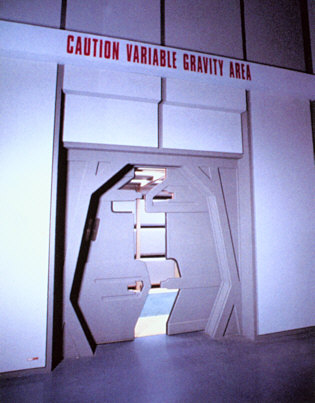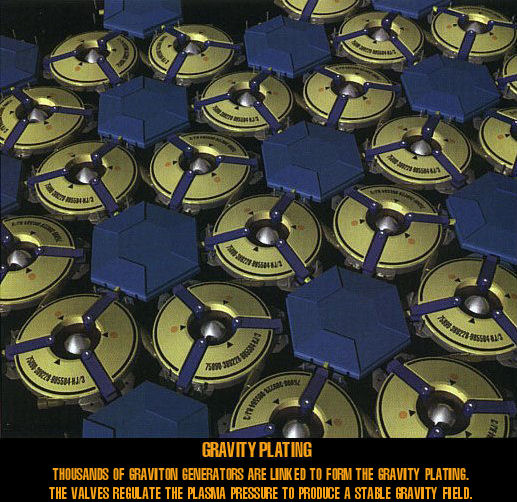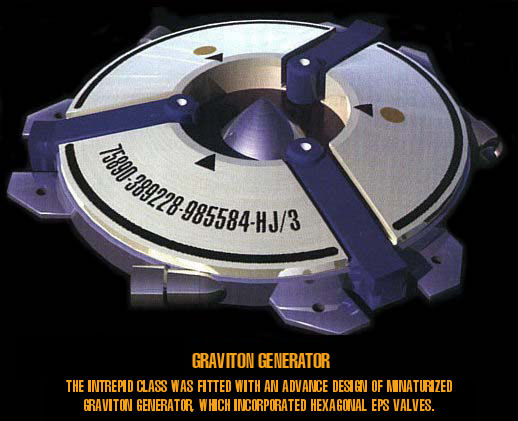YOU ARE ACCESSING THE LCARS COMMAND INTERFACE - TECHNICAL DATABANK
GRAVITY GENERATION
The problems of operating in a micro-gravity environment (such as weakening of the skeletal structure) had been well documented by orbital research stations, such as Sky Lab and the Russian space station 'Mir' by the end of the 20th Century in the sol system. To overcome these difficulties, the first human-built interstellar craft of the late 21st Century simulated gravity on long-duration missions by the use of rotating centrifuges, which was an acceptable, but bulky solution for the time.
Organic life forms require gravitational and electro-magnetic fields, similar to those found on most M-Class worlds, to ensure proper cellular growth. In the following days of space travel Low-level EM field devices simulated planetary background electrical and magnetic fields were used, and the crews of many 20-30 year flights arrived in a healthy state.

By the 22nd Century, technological advances had allowed the creation of artificial gravity devices small enough to use on most Starships. A network of small artificial gravity devices, working together to provide the proper sense of 'down'. This network is also tied into the inertial dampening system to minimize motion shock during flight. Although the fields between devices do overlap slightly, if they have been arranged and tuned properly, the effect is barely noticable.
The gravitational field itself is created by a controlled stream of gravitons, like the basic physics behind the tractor beam. Power from the Electro-Plasma System (EPS) is channelled into a hollow chamber of anicium titanide 454, a sealed cylindrical chamber measuring 50cm in diameter and 25cm high. Suspended in the center of the chamber, in pressurised chrylon gas, is a superconducting stator of thoronium arkenide. Once at a rotational rate of 125,540 rpm (1.1832 x 10^7 rads/sec), generates a gravitational field with a short lifetime, in the order of a few picoseconds. This decay time necessitates the additional of other devices beyond 30m distance. The field is close enough to being uniform to allow natural walking without a gravity gradient from head to foot, long a problem in centrifugal systems.

The superconducting stator remains suspended from the time of manufacture, requiring only a synchronising pulse of energy from the EPS system approximately once every 60 minutes. In the event of EPS failure, the stator will continue to provide an attractive field for up to 240 minutes, though after the first hour a degradation of field strength to around 0.8g will be detected. Any perceived ship motions that might disturb the stator gyroscopically are dampened by sinesoidal ribs on the inner surface of the anicium titanide chamber, effectively absorbing motions with an acceleration of less than 6cm/sec. All motions with higher acceleration are dealt with by the ships inertial dampening field.


Gravity generators are located throughout the habitable volume of most spacecraft. Because of this, inertial potential can vary from one location to the other, especially during harsh manoeuvres. In order to allow translation of excess inertial potential to other parts of the ship, gravity generators are connected to each other by a network of small waveguide conduits that allow field bleed, hence increasing gravitational stability.



Last edited by Adge - September 2004

The problems of operating in a micro-gravity environment (such as weakening of the skeletal structure) had been well documented by orbital research stations, such as Sky Lab and the Russian space station 'Mir' by the end of the 20th Century in the sol system. To overcome these difficulties, the first human-built interstellar craft of the late 21st Century simulated gravity on long-duration missions by the use of rotating centrifuges, which was an acceptable, but bulky solution for the time.
Organic life forms require gravitational and electro-magnetic fields, similar to those found on most M-Class worlds, to ensure proper cellular growth. In the following days of space travel Low-level EM field devices simulated planetary background electrical and magnetic fields were used, and the crews of many 20-30 year flights arrived in a healthy state.

By the 22nd Century, technological advances had allowed the creation of artificial gravity devices small enough to use on most Starships. A network of small artificial gravity devices, working together to provide the proper sense of 'down'. This network is also tied into the inertial dampening system to minimize motion shock during flight. Although the fields between devices do overlap slightly, if they have been arranged and tuned properly, the effect is barely noticable.
The gravitational field itself is created by a controlled stream of gravitons, like the basic physics behind the tractor beam. Power from the Electro-Plasma System (EPS) is channelled into a hollow chamber of anicium titanide 454, a sealed cylindrical chamber measuring 50cm in diameter and 25cm high. Suspended in the center of the chamber, in pressurised chrylon gas, is a superconducting stator of thoronium arkenide. Once at a rotational rate of 125,540 rpm (1.1832 x 10^7 rads/sec), generates a gravitational field with a short lifetime, in the order of a few picoseconds. This decay time necessitates the additional of other devices beyond 30m distance. The field is close enough to being uniform to allow natural walking without a gravity gradient from head to foot, long a problem in centrifugal systems.

The superconducting stator remains suspended from the time of manufacture, requiring only a synchronising pulse of energy from the EPS system approximately once every 60 minutes. In the event of EPS failure, the stator will continue to provide an attractive field for up to 240 minutes, though after the first hour a degradation of field strength to around 0.8g will be detected. Any perceived ship motions that might disturb the stator gyroscopically are dampened by sinesoidal ribs on the inner surface of the anicium titanide chamber, effectively absorbing motions with an acceleration of less than 6cm/sec. All motions with higher acceleration are dealt with by the ships inertial dampening field.


Gravity generators are located throughout the habitable volume of most spacecraft. Because of this, inertial potential can vary from one location to the other, especially during harsh manoeuvres. In order to allow translation of excess inertial potential to other parts of the ship, gravity generators are connected to each other by a network of small waveguide conduits that allow field bleed, hence increasing gravitational stability.


Last edited by Adge - September 2004